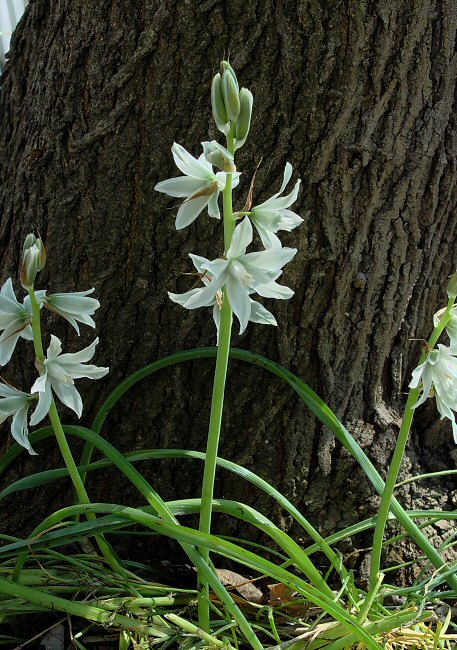Ornithogalum nutans L.
Star Of Bethlehem

Introduced
CC = *
CW = 5
MOC = 3
© DETenaglia
Ornithogalum nutans L.Star Of Bethlehem | |
 |
Introduced CC = * CW = 5 MOC = 3 |
© DETenaglia |
|
Family - Liliaceae Habit - Perennial forb, with bulbs covered by a membranous to papery, smooth, outer coat, lacking the odor of onion or garlic, glabrous. Stems - Aerial stems erect, to 50 cm, unbranched, single from the base, terete, green, glabrous. Leaves - Basal, 20-50 cm long, 5-15 mm wide, linear, flat, green with a white midrib on the upper surface, glabrous. Inflorescences - Terminal racemes of 3-12 flowers. Pedicels to 1 cm long in flower, glabrous, ascending in bud, nodding in flower. Each pedicel subtended by a leaflike, long-tapered bract, this brownish, glabrous, to 4 cm long, 1 cm broad at the base. Flowers - Perianth 1.5-3.0 cm long. Tepals 6, spreading. glabrous, white with a green midstripe, acute, oblong-lanceolate, distinct. Stamens 6, erect, connivent around the style, the filaments flattened, tapering above the middle to narrow tips. Some (3) of the filaments expanded beyond the anthers with two erect appendages. Anthers pale yellow to white, to 5 mm long, 2 mm broad. Ovary dark green, glabrous, ovoid, 3-ribbed, 5 mm long in flower, 3 mm in diameter, 3-locular, placentation axile, ovules numerous. Style white, 7-8mm long, glabrous, with 2 vertical grooves.
Flowering - April - May. Habitat - Cultivated and rarely escaped. Persistent around old homesites and cemeteries. Origin - Native to Asia. Lookalikes - O. umbellatum, which is far more common. Other info. - This attractive species is commonly cultivated throughout Missouri, rarely escaping. It has been recorded from only a few scattered locations, both in Missouri and in the continental U.S. It is much less common than the closely related O. umbellatum which is escaped nearly throughout the state. The two can be distinguished by the length of the lower flower stalks, which are shorter (up to 1 cm) in O. nutans, vs. 2-6 cm in O. umbellatum. In addition, the flowers of O. nutans nod at maturity, and the plants tend to be more robust overall than O. umbellatum. Photographs taken off College Ave., Columbia, MO., 4-11-04. |